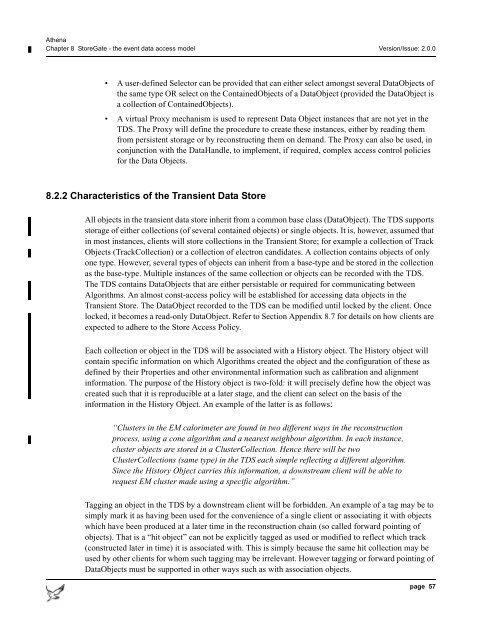Athena Developer Guide
Athena Developer Guide
Athena Developer Guide
Create successful ePaper yourself
Turn your PDF publications into a flip-book with our unique Google optimized e-Paper software.
<strong>Athena</strong><br />
Chapter 8 StoreGate - the event data access model Version/Issue: 2.0.0<br />
• A user-defined Selector can be provided that can either select amongst several DataObjects of<br />
the same type OR select on the ContainedObjects of a DataObject (provided the DataObject is<br />
a collection of ContainedObjects).<br />
• A virtual Proxy mechanism is used to represent Data Object instances that are not yet in the<br />
TDS. The Proxy will define the procedure to create these instances, either by reading them<br />
from persistent storage or by reconstructing them on demand. The Proxy can also be used, in<br />
conjunction with the DataHandle, to implement, if required, complex access control policies<br />
for the Data Objects.<br />
8.2.2 Characteristics of the Transient Data Store<br />
All objects in the transient data store inherit from a common base class (DataObject). The TDS supports<br />
storage of either collections (of several contained objects) or single objects. It is, however, assumed that<br />
in most instances, clients will store collections in the Transient Store; for example a collection of Track<br />
Objects (TrackCollection) or a collection of electron candidates. A collection contains objects of only<br />
one type. However, several types of objects can inherit from a base-type and be stored in the collection<br />
as the base-type. Multiple instances of the same collection or objects can be recorded with the TDS.<br />
The TDS contains DataObjects that are either persistable or required for communicating between<br />
Algorithms. An almost const-access policy will be established for accessing data objects in the<br />
Transient Store. The DataObject recorded to the TDS can be modified until locked by the client. Once<br />
locked, it becomes a read-only DataObject. Refer to Section Appendix 8.7 for details on how clients are<br />
expected to adhere to the Store Access Policy.<br />
Each collection or object in the TDS will be associated with a History object. The History object will<br />
contain specific information on which Algorithms created the object and the configuration of these as<br />
defined by their Properties and other environmental information such as calibration and alignment<br />
information. The purpose of the History object is two-fold: it will precisely define how the object was<br />
created such that it is reproducible at a later stage, and the client can select on the basis of the<br />
information in the History Object. An example of the latter is as follows:<br />
“Clusters in the EM calorimeter are found in two different ways in the reconstruction<br />
process, using a cone algorithm and a nearest neighbour algorithm. In each instance,<br />
cluster objects are stored in a ClusterCollection. Hence there will be two<br />
ClusterCollections (same type) in the TDS each simple reflecting a different algorithm.<br />
Since the History Object carries this information, a downstream client will be able to<br />
request EM cluster made using a specific algorithm.”<br />
Tagging an object in the TDS by a downstream client will be forbidden. An example of a tag may be to<br />
simply mark it as having been used for the convenience of a single client or associating it with objects<br />
which have been produced at a later time in the reconstruction chain (so called forward pointing of<br />
objects). That is a “hit object” can not be explicitly tagged as used or modified to reflect which track<br />
(constructed later in time) it is associated with. This is simply because the same hit collection may be<br />
used by other clients for whom such tagging may be irrelevant. However tagging or forward pointing of<br />
DataObjects must be supported in other ways such as with association objects.<br />
page 57
















